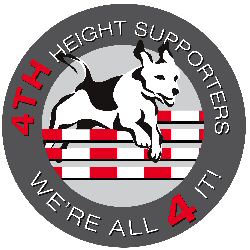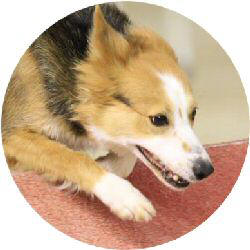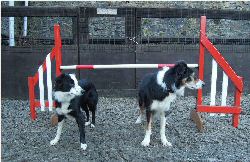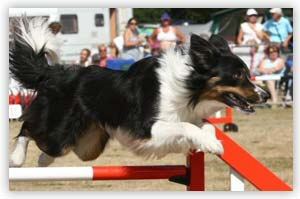A change of heart...
 As
an agility handler of more than 20 years, Ann Harmes has seen many changes in our sport, mostly
she would say for the better. It is amazing to see how agility has grown and developed - indeed
beyond recognition - from when she first started competing with her crazy working sheepdog-
although, some things never change! When asked to write this piece for the
4th Height Supporters Group, she thought it would be of
value to canvas the views of her friends, and those whom she admires within the sport, both as
handlers and professionals. Here she shares their thoughts as well as her own in a differing
perspective. As
an agility handler of more than 20 years, Ann Harmes has seen many changes in our sport, mostly
she would say for the better. It is amazing to see how agility has grown and developed - indeed
beyond recognition - from when she first started competing with her crazy working sheepdog-
although, some things never change! When asked to write this piece for the
4th Height Supporters Group, she thought it would be of
value to canvas the views of her friends, and those whom she admires within the sport, both as
handlers and professionals. Here she shares their thoughts as well as her own in a differing
perspective.
Resistance to change, as in most walks of life, comes from
many perspectives, and all changes are met with many views and, occasionally, controversy. I
can recall, many years ago, hearing about a proposed 4th height for Kennel Club agility and, I
will be totally honest, that I really didn't pay a great deal of attention. It didn't affect me
at the time, so I suppose I could be accused of the 'I'm alright Jack' philosophy. If it ain't
broke' (at least for me) and so on.
It is difficult, without actually experiencing something, or
walking in someone else's shoes, to truly understand its impact. Many people believe that a 4th
height dumbs down the sport in some way, and that 'elite performance' isn't achieved by making
things easier for our dogs, but instead will in some way dilute their performance or indulge
less competitive partnerships. I hope some of the comments I have gathered from friends and
fellow agility handlers will help to dispel these myths.
My experience is quite to the contrary. My Grade 7 dog
Noonoo has been fairly competitive. She is what I would describe as a 'capable dog' - fairly
talented but not one that would appear in a list of top UK agility dogs. Nothing wrong with
that. I am incredibly proud of her. However, after qualifying her for the World Agility Open,
where she ran at the lower height of 550mm, I had what I would describe as an epiphany! The
difference to her style of jumping, her ability to use her drive and athleticism for getting
around the course was quite something! Not only did Noonoo excel at this height, but it also
opened my eyes to other dogs on a world stage that can only be described as incredible!
 I
was watching what I would consider to be the most competitive and exciting height category I
had ever seen. This was not dumbing down in any sense of the word. It was incredibly skilled
and exciting! These dogs were awesome! I talked to other handlers running in this category from
the UK and abroad, and they all seemed to feel the same. I can see why there is now a strong
movement in Europe to include a lower height and understand many countries - just like the UK -
want to move towards its inclusion. I
was watching what I would consider to be the most competitive and exciting height category I
had ever seen. This was not dumbing down in any sense of the word. It was incredibly skilled
and exciting! These dogs were awesome! I talked to other handlers running in this category from
the UK and abroad, and they all seemed to feel the same. I can see why there is now a strong
movement in Europe to include a lower height and understand many countries - just like the UK -
want to move towards its inclusion.
The tide is definitely turning, and those with informed
opinions and experience just know this is right for smaller 'Large' dogs.
I am very grateful to Charlotte Harding, with her dog Ag.Ch.
Rujaff Red Hot Scandal, for sharing her thoughts with us, and providing such an insightful
view.
Charlotte tells us, 'Originally I didn't see the need for
a 4th height. However, over the last 12 months I have changed my mind. Watching dogs at UKA
and at the WAO (World Agility Open), where dogs compete very comfortably at 'Standard' has
made me realise how much better it would be to have a 550mm jump height slotted between our
current heights of 450mm and 650mm. I competed abroad for a week in Denmark in July 2014,
where all dogs in the first grade and Open classes competed on lower jumps, plus heights
being lower at EEuropean Open (EO) - for Large dogs at least). This gave me an opportunity to
see that other countries also appreciate the value in dogs jumping a lower height. Including
a 4th height in the UK should still mean that these dogs could be competitive at
international level. For example, Jess Clarehugh and Cara achieved medals at both EO and FCI
at Large, but competes at WAO at Standard height.
My collie has now won 5 CCs and a silver medal at this
year's FCI World Championships so could be considered competitive, but I train her almost all
year round at 550mm and very rarely on 650mm jumps, despite her measuring well into Large at
19.5in. At almost six years old, she has never had an injury. Lee Windeatt is another top
handler who has had two Agility Champions with no injuries who rarely trains on full height.
We both train on lower jumps as we feel it is better for the dogs. I would, therefore, fully
support the introduction of a 4th height, as I feel it would be better for a dog's well
being, as well as providing a natural progression of heights offered in Kennel Club agility.
After all, the Kennel Club's motto is 'agility for all'.'
A great insight into a changing view on jump heights, and
how Charlotte's international experience has influenced and altered her view of how a 4th
height would and could benefit dogs in the UK.
 Following
my own change of heart, I have been aware of many well known handlers expressing the same
views, and I expect that this is primarily driven by opportunity from European competitions
such as the World Agility Open, the IFCS, and the increase in popularity of these events. Live
streaming, Youtube and social media has made it possible for Agility to become a worldwide
community that we can access and be a part of. Following
my own change of heart, I have been aware of many well known handlers expressing the same
views, and I expect that this is primarily driven by opportunity from European competitions
such as the World Agility Open, the IFCS, and the increase in popularity of these events. Live
streaming, Youtube and social media has made it possible for Agility to become a worldwide
community that we can access and be a part of.
We can now watch the FCI competitions from the comfort of
our laptop, analyse runs, and all become ‘armchair experts'. However, I am sure that the growth
in such opportunities has also resulted in an increased awareness of the excitement that the
550mm height category brings. Watching handlers such as Karen Marriott,
Niina-Liina Linna
and Jess Clarehugh at this height cannot help but cause goose bumps to those who watch! So it
is no wonder that the European forums are frequently flowing with questions from handlers
asking why they also don't have the opportunity to run their dogs on a 4th height.
Here are some comments from Jane Ellen Christiansen from
Denmark, a former FCI World Championship team member, who feels passionately about the
inclusion of a 4th height in the future of agility:
For me it seems we have a group of dogs that jumps
considerably higher than most other dogs. For instance, the medium dogs jump a maximum 29%
higher than their own size. Large dogs may jump up to 51% higher than themselves. A 4th
height would make it possible to set more fair rules where we can find heights where there is
a consistency in how much higher a dog has to jump compared to its height. In my opinion, any
person buying a healthy happy dog should be able to compete in agility. It seems that a group
of people easily get left out as they might not want to jump their dogs on heights that are
physically hard on the dog. Or maybe even worse ... they will keep competing and ignore the
struggle of the dog.
When it comes to the discussion about the jump heights
related to different breeds of dogs, I think that we should keep our eyes on the goal.
Better, more equal rules for all dogs regardless of breed. Some people are very focused on
Border Collies and the fear that more small BCs will be bred, but there are so many other
breeds that would benefit from a 4th height - breeds like Mudis and Pyrenean Sheepdogs, etc.
Breeds that naturally have a height that is around the cut off between Medium and
Large. Actually some of these breeds are being bred smaller than the standard as things are
now. People also get worried how it will affect the competition aspect. Of course, we should
take that in to account as well, but I hope that we still can keep the eyes on the goal as I
said ... making better, more equal rules for all dogs.'
Martin Reid also commented. 'Having competed for many
years in the UK at 650mm with a dog which would most likely measure into this new 4th height
category, then competed internationally at a height of 550mm, the difference is phenomenal.
Not only was my dog more happy, comfortable and confident, I was, too. This was because I
could see how much he was benefitting at jumping a more suitable height for his size and
structure.'
 Another
UK handler to inspire me with her smaller than average BC is Lauren Langman. Her dog Tiki is,
for me, a model example of an amazingly athletic BC. She has very short legs, and even though
she can hold her own in Large Championship agility, she cannot be very much outside the Medium
measure. I have had many discussions with Lauren over the last two years about this issue and I
know that she has supported the inclusion of a 4th height in KC agility for many years, both
from an inclusive point of view and a competitive view. Another
UK handler to inspire me with her smaller than average BC is Lauren Langman. Her dog Tiki is,
for me, a model example of an amazingly athletic BC. She has very short legs, and even though
she can hold her own in Large Championship agility, she cannot be very much outside the Medium
measure. I have had many discussions with Lauren over the last two years about this issue and I
know that she has supported the inclusion of a 4th height in KC agility for many years, both
from an inclusive point of view and a competitive view.
Lauren tell us, 'After watching the 22 inch category
closely and seeing them as the most competitive of all the heights in many other countries, I
now fully support the need for a 4th height in the UK.'
Lauren feels that this will allow all breeds and types to
stay in the game and she firmly believes that it is not only attractive, but vital for the
broad and well rounded growth of our sport. Lauren and Tiki have qualified for the IFCS GB
team for 2015 so they will most certainly have their moment on a world stage at a height that I
am convinced will ensure that this little dog will shine!
As competitors, we are always concerned with the health and
wellbeing of our dogs, and I have always taken the time to have the conversation with regards
to jump heights with the individuals who I respect from a health perspective. I recently took
the opportunity to address Dr. Christine Zink on the subject at a seminar I attended entitled
The Canine Athlete, and was pleased that she was happy to confirm my growing belief that
it is better for these smaller Large dogs to jump a lower height. Indeed, she was surprised
that anyone would not think that this was the case. My discussions with Lydia Critchlow
endorsed this view also.
'As Show Manager at our club, the 4th height opens up
opportunities for more dogs and handlers to succeed in agility. As a McTimoney Therapist I
agree with proposals for the 4th height. This would open up accessible competition for the
smaller height 'Large' dogs. Training these dogs over a lower jump height would increase
their competition career.'
Evidently in Canada and the US, the opportunity for dogs to
jump a range of heights is available, and indeed world renowned trainer and competitor Susan
Garrett echoed this sentiment which I felt I must share as it most certainly sums up the notion
of ‘why on earth not?'
She says, 'I can't imagine an agility association not
having a 22in height class. Being raised in the sport where we have always had at least 4
jump heights it is inconceivable to me not to have all 4. What is the point really? Why make
a dog that measures 18in tall jump a 26in jump? I am thrilled that with Feature (her World
Championship dog) I have the option of jumping her at 22in when she gets older (because she
does measure into the 22in class but in preparation for FCI I choose to jump her at 26in . .
. but at least it is my option . . . no one is forcing me to do it.) Having a 4th jump height
just makes agility more inclusive, allowing healthy sound dogs of all abilities and ages to
play.'
Another very important view on this subject are those
expressed by our measurers, and it is no coincidence that many of them feel so strongly about
the need for the inclusion of an additional 4th height, I asked Jackie Kenny to provide me with
her view as a KC measurer and here is what she had to say:
'As an official Kennel Club measurer who measures dogs on
a regular basis, I am often dismayed when I have to measure a dog that is clearly just a bit
too large for the Medium category but also way too small for the Large height category. What
is the option for these dogs? There are really quite a few. If the dog can manage the full
height jumps, then that's what height it competes at. If it cannot, then the dog either does
the Allsorts classes when they are on offer at KC shows or the dog and handler are left to
compete at other organisations where the dog may jump lower heights.'
I do find it quite sad that there is currently no place for
these dogs in KC Agility, despite the mission statement of the Kennel Club supporting 'Fit for
Function' as a philosophy and yet so many fall through the discriminative
net.
 I
find it interesting that the prospect of research has been held up as a way forward, and whilst
no one would honestly suggest that this was a bad thing, it is certainly not a good thing if it
is used to kick the support for such a change into the long grass. We now find two years on
that reportedly nothing has been done in this respect. I found fellow agility competitor and
friend Dr Audra Hurst's comments interesting, especially coming from an academic perspective. I
find it interesting that the prospect of research has been held up as a way forward, and whilst
no one would honestly suggest that this was a bad thing, it is certainly not a good thing if it
is used to kick the support for such a change into the long grass. We now find two years on
that reportedly nothing has been done in this respect. I found fellow agility competitor and
friend Dr Audra Hurst's comments interesting, especially coming from an academic perspective.
I have a dog that
measures 46cm and a dog that measures 56cm. One has to jump around 10cm higher than his
height, the other nearly 20cm. It isn't surprising that I really don't understand why a 4th
height can't be brought in without research. After all, it doesn't seem to have to take
place for other welfare proposals. How can it be unsafe for my 46cm dog to jump 55cm when
it's considered safe for my 56cm dog to jump 65cm? I will always support robust,
peer-reviewed research, but it is beyond me why it is needed here.'
The positive note to draw
my thoughts to a close is that we now have an opportunity to vote. There is now a proposal
placed on the January Agenda for the Agility Liaison Council for a 4th height in KC
Agility. I do hope you have found some of the detail interesting and thought-provoking. You
may have guessed it is something I feel quite passionate about, and I know there are many
agility handlers who feel the same, some of whom have contributed here. If you would like to
see our agility flourish and move on with growing current opinion, please don't forget to go
along to your regional meeting and have your say.
www.thekennelclub.org.uk/activities/agility/agility-liaison-council/

For more
information about the 4th Height Supporters Groups, visit
http://areyou4it.org/ or
https://www.facebook.com/#!/groups/123817961094745/ or email:
fourth_height@yahoo.co.uk
 About
the author... About
the author...
Ann Harmes
began training in Agility with her first dog Mostly Moss over 20 years ago, having started
their introduction to dog training in Obedience. Moss took her to the dizzy heights of
Advanced and won the NCDL and Crufts Singles titles before his career was cut short by injury.
Noggin the Nog was Ann's second dog whose agility career was quite infamous- winning many major
titles for both her and her husband Stuart who continued to run him after the arrival of their
daughter.
Ann now competes at Championship level with her own dogs Noonoonog and Darleyfalls
Woof with a good degree of success, representing Wales at the WAO for the last four years and
qualifying for many major events.
Ann also runs and sponsors the Camddwr Cup, a national Agility Series
culminating in a Grand final held at Malvern as an annual event. She is also Director of
Camddwr Canine Ltd, a well established business providing quality products for sporting and
active Dogs.
Ann has provided individualised training in the UK for the past 15 years,
offering bespoke training days, seminars as far afield as South Africa, and specialising in an
individualised approach to training.
First
published 3 December 2014
|